Bougainvilleas
BackBougainvilleas are spectacular flowering climbers originally from South America that love the heat and will easily tolerate dry conditions. Surprisingly what most people think are the colourful flowers are actually modified leaves called bracts. These bracts range in colour from red, orange, pink, purple, mauve, gold and good old white. The true flowers are small and white and often completely obscured by the amazing bracts (look closely at the first photo and you can spot a few).
Many of the varieties available are tall vigorous growers that look fabulous grown over walls, pergolas and along verandas. If your space is limited then select a dwarf cultivar (like one from the Bambino series) which can be easily grown pots in courtyards or on balconies. Either way if you’re after vibrant colour that lasts for months then a bougainvillea will definitely fit the bill.
How To Grow Bougainvilleas
Bougainvilleas are woody climbers that use their arching thorny canes to scramble upwards. Taller varieties will need strong support to grow on and initially a bit of training to push the canes in the direction you want. Be sure to plant in a location where there is plenty of room for them to grow to minimise pruning needs.
Bougainvilleas will tolerate light frosts with younger plants needing more protection than older woody plants.
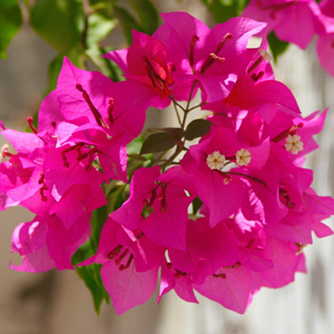
Bougainvilleas are loved for their intense colours
Plant in full sun for maximum flowering. They aren’t too fussy about soil type as long as it has good drainage. Nonetheless you’ll get better growth if you work in some compost, aged manure and/or organic pelletised fertiliser. This is especially important if you have very poor soils. Clay soils are not ideal due to their poor drainage but if you want to give it a go apply some gypsum and do a raised planting.
For a potted bougainvillea choose a pot that’s at least 50cm in diameter and has plenty of drainage holes. Select a dwarf variety for the best results.
Whichever way you go be gentle with their roots when planting out as they don’t like having their roots disturbed. Water in with OCP eco-seaweed to reduce transplant shock.
By the way if you want to try your luck at taking cuttings these should be done in spring. Take a piece about 25cm long and remove lower leaves. Sink 2/3 of the cutting into a cacti potting mix (or make your own by adding sand to regular potting mix). Water in with OCP eco-seaweed and place in the shade. Keep the potting mix moist but not wet. When new shoots start to appear gradually move the cutting into the sun. Your new plant should be ready by the end of summer.
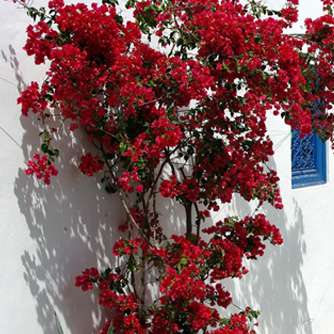
Scarlet red bougainvillea is unmissable against this white wall
Fertilising Bougainvilleas
Bougainvilleas are one of those plants that handle neglect well and once established will put on a magnificent colourful show with very little attention at all. However they are surprisingly hungry plants and will greedily gobble up any nutrients you give them. Give them too much though and you’ll get a lot of green leaves and few flowers. So hands up who’s confused now with what to do? Let’s simplify things:
- New Plants – these guys will benefit from being fed well to encourage growth and get them to fill out the space you’ve allotted for them. Liquid feed with OCP eco-aminogro and OCP eco-seaweed every 2-3 weeks and you’ll have them charging along. 2-3 times a year boost the soil with some organic matter like compost and/or aged manures.
- Established Plants In Garden Beds – Once they’ve reached the desired size you can completely ignore them and they’ll keep rewarding with flowers. However as most Aussie soils are pretty poor quality it doesn’t hurt to give them a dose of organic pelleted fertiliser once a year along with some compost/aged manure.
- Potted Plants – these guys will benefit from a monthly dose of OCP eco-aminogro and OCP eco-seaweed to keep them at their best.
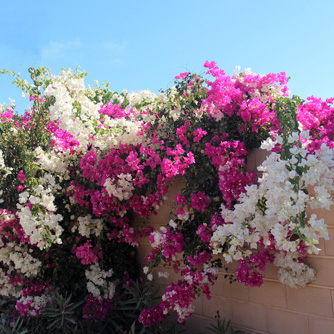
Plant two different coloured bougainvilleas together for eye catching contrast
Pruning Bougainvilleas
First up when flowering finishes you should prune off the spent heads. This helps to keep plants tidy.
From time to time bougainvilleas will produce vigorous new shoots from the base called water shoots. These can be helpful on new plant as they grow quickly and fill in space. However on an established plant they should be pruned off to keep it under control.
If your bougainvillea gets too large for your liking then the good news is they can handle very hard pruning. It’s best to prune after summer flowering so you don’t miss their flowers but pruning can be done anytime during the warmer months. Basically cut them back as hard as you want and before you know it you’ll have replacement growth appearing. Hard pruning like this often results in the growth of vigorous water shoots which may need some additional trimming.
Bougainvilleas can also be pruned and trained into topiaries, large hedges or even as ‘trees’. Just be sure to choose a variety that grows to the right size to minimise how much pruning you need to do in the long run.
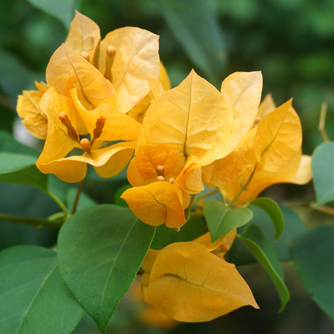
Bougainvilleas are also available in softer tones like this pale orange
Bougainvillea Flowering Problems
If your bougainvillea fails to put on a spectacular show then it’s likely that you’re giving it too much love. Excessive watering can lead to more foliage growth and fewer flowers. Try keeping established plants a bit drier, especially during the warmer months, and that should kick start better flowering.
The other common reason is too much fertiliser especially if it’s high in nitrogen which promotes leaf growth. This won’t happen if you stick to our fertilising recommendations above as the nitrogen levels will be in balance with other nutrients. Artificial fertilisers on the other hand are often very high in nitrogen and are best avoided (plus they’re not organic!). If you fear you’ve overdone it on the nitrogen front apply some potash to boost potassium levels and give weekly doses of OCP eco-seaweed.
One final reason is lack of sunlight. Bougainvilleas just love the sun. While they can handle some shade it usually results in poorer flowering.
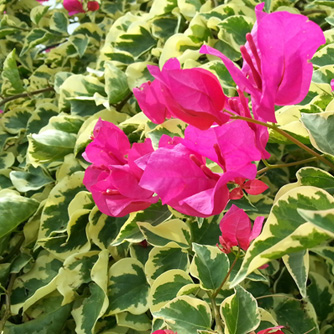
Bougainvillea with variegated foliage
Pests and Diseases of Bougainvilleas
Bougainvilleas suffer from few pests and diseases with established plants powering on year after year. Occasionally they might suffer from the following though:
- Sapsuckers like aphids, mealybugs and mites – spray with OCP eco-oil or OCP eco-neem depending on the particular pest.
- Scale - sometimes this pest appears but can be controlled with an organic insecticide.
- Caterpillars – spray with OCP eco-neem to protect small plants. Larger plants can usually handle the odd caterpillar having a munch.
- Powdery mildew – if this disease appears increase air circulation around the plant and avoid wetting leaves when watering. Regular applications of OCP eco-seaweed and OCP eco-aminogro will also build strong healthy plants with more disease resistance. If necessary spray with an organic fungicide.
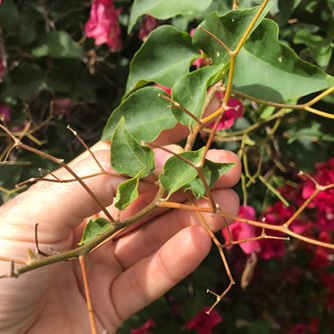
Finished flower head ready to be trimmed back


